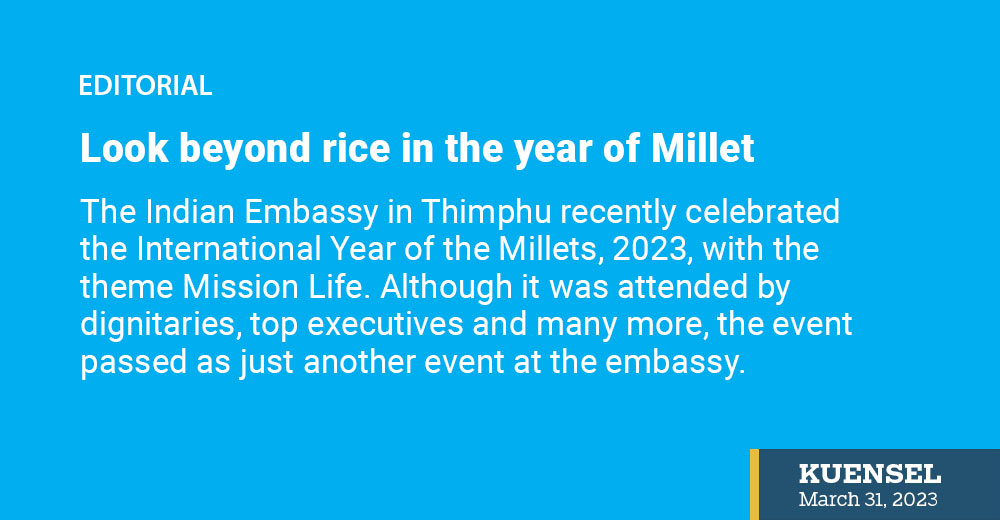The Indian Embassy in Thimphu recently celebrated the International Year of the Millets, 2023, with the theme Mission Life. Although it was attended by dignitaries, top executives and many more, the event passed as just another event at the embassy.
With reports of a global rice crisis, rice cultivation becoming more eco-unfriendly and Bhutan’s rice import bill ballooning, Millet for Life or any substitute to rice should receive greater attention. For context, 2023 was declared as the year of the Millet by the UN at India’s request. It was primarily to reduce the dependence on rice and improve healthy living.
The staple diet that most of us eat thrice a day is increasingly being blamed for non-communicable diseases, especially diabetes. There are scientific studies that say rice is fueling diabetes, particularly in Asia where it is most consumed.
Producing rice, meanwhile, is becoming more difficult. Shortage of land, water, and labour needed in producing rice are factors for the rice crisis. It is no different in Bhutan, if not worse. Everybody is trying to shift to other cereals or new varieties like flood or drought-resistant varieties.
Our research centres introduce new varieties, but farmers still hang on to the old or are not well aware. We are still taking pride in our local varieties even with dwindling yields or vulnerability to the impact of climate change. The way we farm has also not changed much.
Rice production is on the decline. This is largely because the area under paddy cultivation decreased by more than 50 percent between 2017 and 2021. Paddy production decreased proportionally from 86,385MT to 40,508MT in the last five years (2017 to 2021). Therefore, rice self-sufficiency is also on the decline. It was 45 percent in 2029 and 37 in 2021.
If producing rice is a challenge, environment-unfriendly and consuming it unhealthy, we have to introduce substitutes. There is already a trend in urban Bhutan. Many skip rice or eat it once a day. It is seen as the main reason behind the increasing waistline or diabetes. Doctors often tell people to cut down on carbs – rice is rich in it.
If rice is difficult to produce, adds to the trade deficit and is not good for health or the environment, looking for alternatives is the way forward. Beyond the rice-growing regions, millet and maize are the staple. This is substituted by imported cheap rice. In some villages, maize or millet is grown as cattle food or for brewing ara. Food made from millet, like dengo (dough), even if nutritious is looked down upon. Dengo, long ago was seen as the food of those who cannot afford rice.
Promoting healthy and easy-to-produce food should be encouraged. At the Indian Embassy celebration, guests had a good time trying on an array of millet dishes curated by chefs and locals alike. Many agreed it was a feast if prepared the right way. If rice is bad for health, wealth and the environment, it could be taken up as a priority, especially if we can produce more with less.


